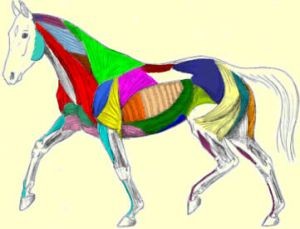
Effect of head-neck positions on the neck muscles activity
Riding the horse with the nose-line in front of or at the vertical gives the desired dressage result of training the horses topline. Riding in a hyper-flexed position trains the underline of a horse. The investigators also argument that extreme cases of hyperflexion can lead to (painfull) spasms in the musculus brachiocephalicus.
The electrical activities of the m. splenius, the m brachiocephalicus and the m. trapezius of 5 horses were measured on both sides, with and without a rider, on both hands and in all three gaits.
The three different Head-Neck positions (HNPs) where: a ‘free’ position, a ‘gathered’ (head higher, neck more flexed) position with the noseline in front of the vertical, and a ‘hyperflexed’ position.
In HNPs with the noseline in front of the vertical the muscles of the topline (m. splenius, m. trapezius) are activated and trained.
In the hyperflexed position the major muscle of the lower line, the m. brachiocephalicus is activated and trained.
The m. brachiocephalicus main function is to move the front limb and schoulder forward and it flexes the neck. Hyperflexion thereby creates a more spectacular movement of the front limbs.
The m. splenius was identified as a functional stabiliser of the head–neck against gravitational forces. The splenius and trapezius muscle contribute to carrying the neck and head against gravity and are part of the muscle-topline of the horse.
> From: Kienapfel, J Anim Physiol Anim Nutr (Berl). 99 (2017) 132-8.(Epub ahead of print). All rights reserved to Blackwell Verlag GmbH. Click here for the online summary.


